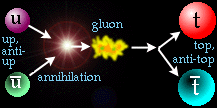Antimatter



For every particle (matter) there is a
corresponding antiparticle (antimatter).
Antiparticles are the same as the corresponding matter
particle in every respect except for their opposite charges.
A proton is electrically positive: an anti-proton is electrically negative.
They both have the exact same mass, so they are affected in the same
way by gravity.
When a particle and its antiparticle meet, they annihilate into pure energy.
This energy may then give rise to neutral force-carrier particles, such as
photons, Z bosons, or gluons.

Some Terminology:
The symbol for an antimatter particle is a bar over the corresponding matter
particle symbol. For example, a proton
( )
has an antiparticle denoted by
)
has an antiparticle denoted by
 ,
pronounced p-bar. The antiparticle of a proton is called an
antiproton. An electron's
(e-)
antiparticle is a
positron
(e+).
,
pronounced p-bar. The antiparticle of a proton is called an
antiproton. An electron's
(e-)
antiparticle is a
positron
(e+).
Here's an interesting question about antimatter that puzzles physicists:
 If matter and antimatter are exactly equal but opposite,
then why is there so
much more matter in the universe than antimatter? Why did matter "win"
instead of antimatter?
If matter and antimatter are exactly equal but opposite,
then why is there so
much more matter in the universe than antimatter? Why did matter "win"
instead of antimatter?
Antimatter and Experiments
Particle physicists use colliding beams of
 and
and
 or
e-
and
e+.
They then study the
numerous particles that result from the force carrier particle's
(a boson) decay.
or
e-
and
e+.
They then study the
numerous particles that result from the force carrier particle's
(a boson) decay.

An example of such an annihilation is the
electron/positron annihilation that
makes
D±
particles.

Look at visual proof of antimatter's existence
(an antiproton/proton annihilation) in an old
bubble chamber photograph (55 kB).
Use your browser's "back" button or
go back to the
 Standard Model Path.
Standard Model Path.

 If matter and antimatter are exactly equal but opposite,
then why is there so
much more matter in the universe than antimatter? Why did matter "win"
instead of antimatter?
If matter and antimatter are exactly equal but opposite,
then why is there so
much more matter in the universe than antimatter? Why did matter "win"
instead of antimatter?
![]() Standard Model Path.
Standard Model Path.